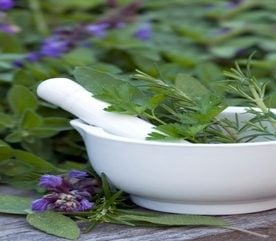How to Enhance Your Landscape with an Herb Garden
If you want a section of your landscape to be devoted just to herbs, you have a choice between two very different styles: the formal approach associated with medieval monasteries and French parterre, or the informal gardens found in many backyards. In either case, locate your culinary garden in a sunny spot as close to the kitchen as possible, advises Rosalind Creasy, landscape designer and author of The Complete Book of Edible Landscaping. Then you can clip and cook.

Let’s look at how you can enhance your landscape with your very own herb garden!
Formal vs. Informal Herb Gardens
Creating and maintaining a formal herb garden is a major commitment, says Creasy, but it can be a fascinating experience. Formal herb gardens involve the use of symmetry, geometric shapes, and the repetition of elements-for example, you might have an even number of rectangular beds with the same border, type of structure, and focal point. Potted plants, topiaries, or espaliered fruit trees can be included.
Often, formal gardens are enclosed by a boxwood hedge or picket fence to accentuate their lines and formal nature. The look is refined, clipped, and tidy. A major challenge, says Creasy, is keeping it that way. It requires continual tending and coping with aesthetic disasters caused by the occasional but inevitable loss of plants. Keep in mind, too, that the repetition required by the design means you can have fewer species in the garden.
An informal herb garden can work in a variety of settings: tucked into the corner of a flower or vegetable garden, lining the front walk of a house, or placed around a patio. As the name implies, there are no strict rules for creating such a garden.
Here are some guidelines:
Place short plants in the front and tall plants in the back.
Put dark plants next to light ones, stiff next to frilly.
Create interest by the way you combine the colour and texture of the foliage.
Avoid arranging herbs by the colour of their flowers because their bloom time is typically quite short.
Research how each herb grows in your region, Creasy advises. That way, you will have realistic expectations about the size your plants will reach, which will help in your design. Also, you may find that in your climate some perennial herbs act as annuals, that others won’t do well at all, or are likely to attract difficult pests. Doing your homework can spare you some failures and frustrations.



